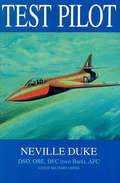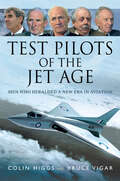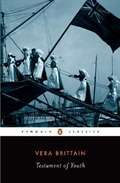- Table View
- List View
Terrorism and the Politics of Response (Routledge Critical Terrorism Studies)
by Nick Vaughan-Williams Angharad Closs StephensThis inter-disciplinary edited volume critically examines the dynamics of the War on Terror, focusing on the theme of the politics of response. The book explores both how responses to terrorism - by politicians, authorities and the media - legitimise particular forms of sovereign politics, and how terrorism can be understood as a response to global inequalities, colonial and imperial legacies, and the dominant idioms of modern politics. The investigation is made against the backdrop of the 7 July 2005 bombings in London and their aftermath, which have gone largely unexamined in the academic literature to date. The case offers a provocative site for analysing the diverse logics implicated in the broader context of the War on Terror, for examining how terrorist events are framed, and how such framings serve to legitimise particular policies and political practices.
Terrorism in Europe (Routledge Library Editions: Terrorism and Insurgency)
by Yonah Alexander Kenneth MyersThis study places terrorist acts in Europe in their historical perspective by examining terrorist and anarchist movements in late nineteenth century Europe. The political and legal aspects of modern terrorism are discussed in detail and the themes and variation in political terrorism are examined fully. In addition, selected case studies of contemporary terrorist movements are considered in the context of the political tradition of the particular country. A comprehensive picture of European terrorism, in its historical and more contemporary ideological and political aspects emerges from this work.
Terrorism in Ireland (Routledge Library Editions: Terrorism and Insurgency)
by Yonah Alexander Alan O'DayWhen originally published in 1984, this book was the first detailed study of terrorism in Ireland. It assesses the situation in Ireland after a decade or more of violence in the North and tests some of the assumptions about the nature of terrorism and discusses the problem in a geo-political context. The authors reflect a variety of disciplines and political outlooks and no single line of argument is offered. They examine how the issue of terrorism has been dealt with by various governments, the church, the media and individuals. The book reveals the complexity of the terrorist problem and dispels some of the myths that have grown up around Irish terrorism.
Terrorism, Criminal Law and Politics: The Decline of the Political Offence Exception to Extradition (Transnational Criminal Justice)
by Julia JanssonRecent atrocities have ensured that terrorism and how to deal with terrorists legally and politically has been the subject of much discussion and debate on the international stage. This book presents a study of changes in the legal treatment of those perpetrating crimes of a political character over several decades. It most centrally deals with the political offence exception and how it has changed. The book looks at this change from an international perspective with a particular focus on the United States. Interdisciplinary in approach, it examines the fields of terrorism and political crime from legal, political science and criminological perspectives. It will be of interest to a broad range of academics and researchers, as well as to policymakers involved in creating new anti-terrorist policies.
Terrorism, Freedom, and Security: Winning without War
by Philip B. HeymanA former Deputy Attorney General of the United States argues that we must preserve our civil liberties and democratic values while fighting terrorism.
Terrorism, Identity and Legitimacy: The Four Waves theory and political violence (Political Violence)
by Jean E. RosenfeldThis book argues that terrorism in the modern world has occurred in four "waves" of forty years each. It offers evidence-based explanations of terrorism, national identity, and political legitimacy by leading scholars from various disciplines with contrasting perspectives on political violence. Whether violence is local or global, it tends to be both patterned and innovative. It elicits chaos, but can be understood by the application of new models or theories, depending upon the methods and data experts employ. The contributors in this volume apply their experiences and studies of terrorists, mob violence, fashions in international and political violence, religion’s role in terrorism and violence, the relationship between technology and terror, a recurring paradigm of terrorist waves, nation-states struggling to establish democratic/elective governments, and factions competing for control within states - in order to make sense of both national and international acts of political violence and to ask and answer some of the most disturbing questions these phenomena present. This book will be of much interest to students of terrorism, religion and violence, nationalism, sociology, war and conflict studies and IR in general.
Terrorism, Jihad, and the Bible: A Response to the Terrorist Attacks
by John MacarthurSeptember 11, 2001 saw the deadliest attack ever launched on American soil, leaving us asking questions such as: Why did God permit such a thing to happen? Was the attack a divine judgment or was it merely an atrocity perpetrated by the forces of evil? How can human beings be capable of such diabolical savagery in the name of religion? And what is the right course of action for our government to take? John MacArthur points us to the Bible for answers to these and many other questions arising out the recent atrocities. He educates readers to the roots of the conflict, linking the religious and political issues that underlie the current turmoil to the Old Testament.
Terrorism: From Robespierre to the Weather Underground
by Albert Parry"A very impressive and comprehensive story on terrorism . . . enormously valuable."--Brian Crozier, former director of the Institute for the Study of Conflict, LondonA compulsively readable analysis of modern terrorism, this brilliant, vital work by a noted expert on terrorism and guerrilla warfare describes the nature of terrorist organizations and events and analyzes the changing nature and evolution of unconventional political warfare. From the genesis of the Great Terror initiated by Robespierre over 200 years ago, to the Black Panthers, the Symbionese Liberation Army, and the mass terrorism of Stalin, Hitler, and Mao, this absorbing work offers unsurpassed insight into seemingly irrational acts of violence and murder. The author, who was born in Russia and as a youth only narrowly escaped being a victim of terrorism, does a superb job of helping readers to understand the causes and nature of terrorism, and how terrorists use intimidation, violence, and bloodshed to threaten the stability of society.
Terrorism: The Basics (The Basics)
by James Lutz Brenda J LutzTerrorism: The Basics is an ideal starting point for anyone interested in one of the most discussed, written about and analysed aspects of modern life. Common misconceptions are dispelled as the authors provide clear and jargon-free answers to the big questions: What does terrorism involve? Who can be classified as a terrorist? What are terrorists trying to achieve? Who are the supporters of terrorism? Can there ever be an end to terrorist activity? These questions and more are answered with reference to contemporary groups and situations allowing readers to relate theory to what they have seen on the news. Written with clarity and insight, this book is the perfect first book on terrorism for students of all levels.
Terrorism: The Basics (The Basics)
by Brenda Lutz James LutzTerrorism: The Basics is an ideal starting point for anyone interested in one of the most discussed, written about and analysed aspects of modern life. Common misconceptions are dispelled as the authors provide clear and jargon-free answers to the big questions: What does terrorism involve? Who can be classified as a terrorist? What are terrorists trying to achieve? Who are the supporters of terrorism? Can there ever be an end to terrorist activity? These questions and more are answered with reference to contemporary groups and situations allowing readers to relate theory to what they have seen on the news. Written with clarity and insight, this book is the perfect first book on terrorism for students of all levels.
Terrorism: The Cuban Connection
by Roger W. FontaineFirst published in 1988, Terrorism: The Cuban Connection examines Cuba’s involvement in terrorism. With a focus on Havana, the book begins by looking at Cuba’s history and the origins of terrorism. As it progresses, the book traces the development of terrorism and explores Cuba’s connections with other parts of the world, including America, Russia, the Caribbean, South America, the Middle East, and Sub-Saharan Africa. Terrorism: The Cuban Connection is a detailed study, equipped with a wealth of key documents and photographs.
Terrorismus neu definieren: Herausforderungen und Perspektiven im Wandel der Paradigmen
by Katarzyna ManiszewskaDieses Buch behandelt zentrale Fragen im Bereich der Terrorismusforschung, die seit Langem zu keinem internationalen Konsens geführt haben. Es erörtert, warum es eine Vielzahl von Definitionen für Terrorismus gibt, gleichzeitig jedoch keine einheitliche Definition auf internationaler Ebene existiert. Dabei beleuchtet es die schwer fassbaren Grenzen, die einer globalen Einigung im Weg stehen.Zwei überzeugende Hypothesen des Buches ebnen den Weg für neue Perspektiven in der Terrorismusbekämpfung. Erstens wird die Notwendigkeit neuer rechtlicher Rahmenbedingungen betont, die sich an die sich wandelnde Natur des Terrorismus anpassen – einschließlich staatlich unterstützter Formen. Zweitens zeigt die Untersuchung der historischen Wurzeln des Terrorismus Muster auf, die zukünftige Strategien zur Terrorismusbekämpfung grundlegend verändern könnten.Basierend auf Interviews mit 20 führenden Expertinnen der Terrorismusforschung aus unterschiedlichen Regionen und Fachrichtungen bietet dieses Buch wertvolle Einblicke und eine umfassende Betrachtung des Themas. Es richtet sich insbesondere an Studierende, Wissenschaftlerinnen und Forscherinnen in den Bereichen Sicherheitsstudien, Politikwissenschaft, Internationale Beziehungen und Terrorismusforschung sowie an politische Entscheidungsträgerinnen, die die komplexen Herausforderungen der Terrorismusbekämpfung in einer sich ständig wandelnden Welt verstehen möchten.
Terrorist Attacks on American Soil: From the Civil War Era to the Present
by J. Michael MartinezUnderstanding the context of terrorism requires a trek through history, in this case the history of terrorist activity in the United States since the Civil War. Because the topic is large and complex, Terrorists Attacks on American Soil: From the Civil War to the Present does not claim to be an exhaustive history of terrorism or the definitive account of how and why terrorists do what they do. Instead, this book takes a representative sampling of the most horrific terrorist attacks on U.S. soil in an effort to understand the context in which they occurred and the lessons that can be learned from these events.
Terrorist Dispatch
by Don PendletonCRIMEAN DEADLOCK Ukrainian militants are the initial suspects in a terrorist attack on Washington, DC, until rumors surface suggesting Moscow was behind the bombing. But the investigation only raises more questions. Was the attack an attempt to mute US criticism of Russia, or a call to action to help suppress Ukrainian dissidents? Only one man can solve the riddle and mete out appropriate punishment: Mack Bolan. From Manhattan's Little Ukraine to the war-torn country itself, Bolan blazes a path of truth and justice to neutralize the threat...and prevent another slaughter on American soil even as the danger increases with enemies and allies emerging on both sides of the Crimean conflict. But the Executioner is no middleman; he has his own war to fight, and he won't stop until his opponents are ashes.
Terrorist Groups and the New Tribalism: Terrorism’s Fifth Wave (Political Violence)
by Jeffrey KaplanThe central focus of this book is a small but vitally important group of movements that constitute a distinct 'fifth wave' of modern terrorism, here called the "New Tribalism". Terrorist Groups and the New Tribalism examines a collection of terrorist or insurgent movements whose similarity in tactics, strategic vision and desire to radically reshape their worlds to conform with a ‘Golden Age’ dream of perfection which is to be achieved through a genocidal or ethnic cleansing process to make way for the emergence of a new, radically perfected tribal utopia in a single generation. These shared strategic and tactical factors allow them to be examined through a comparative lens as a distinct ‘fifth wave’ of modern terrorism. Structured around the theoretical framework of David Rapoport’s Four Waves thesis, the book examines anomalous movements that began within a distinct wave of international terrorism, but, following a crisis model, has turned inwards toward radical localism, tribalism and xenophobia. The text is divided between theory and in depth case studies of the Ugandan Lord’s Resistance Army and the Sudanese Janjaweed. It concludes with a design for further, field-work based research. This book will be of interest to students of Terrorism and Political Violence, Genocide, Conflict Studies, African politics and Political Science in general. Jeffrey Kaplan is an Associate Professor of Religion and the Director of the Institute for the Study of Religion, Violence and Memory at the University of Wisconsin Oshkosh. He is the author of 11 books on terrorism and political violence.
Terrorist Rehabilitation and Counter-Radicalisation: New Approaches to Counter-terrorism (Political Violence)
by Rohan Gunaratna Lawrence Rubin Jolene JerardThis book seeks to explore the new frontiers in counter-terrorism research, analyses and practice, focusing on the imperative to rehabilitate terrorists. The post-9/11 world is in a very early stage of global rehabilitation both of terrorists and criminals. Nonetheless, some correctional rehabilitation programs have led convicted and suspected terrorists to express remorse, repent, and recant their violent ideologies and re-enter mainstream politics, religion and society. Although operational counter-terrorism initiatives have received both investment and attention, strategic counter-terrorism initiatives that ultimately end violence including terrorism but require patience and sustained efforts have been neglected by governments and received inadequate public coverage. This book is an early attempt to examine a few case studies both by practitioners and scholars. This book provides a better understanding of the process of deradicalization, and will be the first step towards exploring the development of tools necessary to examine and address challenges faced by practitioners. This book will be of much interest to students of terrorism and political violence, radical Islam, conflict resolution, war and conflict studies and IR/Security Studies.
Terrors
by Richard A. LupoffRanging from the mysterious to pulp action to the Lovecraftian, this vivid collection of short fiction explores a world of radio heroes, masterful villains, and creatures from places unknown.
Terrors
by Richard A. LupoffRanging from the mysterious to pulp action to the Lovecraftian, this vivid collection of short fiction explores a world of radio heroes, masterful villains, and creatures from places unknown.
Test Pilot
by Neville DukeThe renowned WWII RAF fighter pilot who went on to set an air speed record tells his story—now with an updated chapter and new photos. Joining the RAF at the beginning of the war, young Neville Duke became a fighter pilot with the crack 92 Squadron at RAF Biggin Hill in 1941. That spring and summer, he survived the air battles over Northern France with the Biggin Hill Wing, often flying as wingman to the legendary Adolph &“Sailor&” Malan, Fighter Command&’s top-scoring pilot at that time. Duke quickly established himself as one of the most successful pilots in North Africa, bringing his score to twenty-one by the end of the Tunisian Campaign, and then took command of 145 Spitfire Squadron in Italy. Leading this unit in the summer of 1944, he brought his score to twenty-eight. Earning numerous honors, he was recognized for his heroism, but the military was only the beginning of his life in aviation. Toward the end of the war, he became an RAF test pilot—and later a member of the RAF High Speed Flight. He would go on to a successful postwar career, playing a key role in the flight development on one of the most famous of all RAF peacetime aircraft—the Hawker Hunter—and taking the world speed record in 1953. An in-depth look at his daring exploits covering both his combat career and his postwar accomplishments, Test Pilot is now updated with an additional chapter, appendices and index, and a completely new selection of photographs.
Test Pilots of the Jet Age: Men Who Heralded a New Era in Aviation
by Colin Higgs Bruce VigarToday, as we board our flights to Adelaide, Zurich, and all points in between, we give little thought to the jet power that will take us there. But, this is only possible because just over 70 years ago a select band of British test pilots was prepared to risk all in the quest to fly further, faster, and higher than ever before. Their quest was fraught with danger; disaster and death were never far away. This book captures eleven of those stories as told by the pilots themselves – their words as to how they took British aviation to the forefront of a new era, the ‘Jet Age’. Britain’s aircraft industry was booming in the years immediately after the end of the Second World War and the demand for test pilots seemingly limitless as new aircraft types rolled off the drawing boards. Meteors, Vampires, Hunters, Comets, Victors, Vulcans and Harriers were some of the aircraft that became world-beaters. Today, these names and the role played by the test pilots in bringing these projects to fruition are all but forgotten. The stories were filmed over a number of years and it is the edited transcripts of those interviews that form a unique and rare perspective on such a pivotal era in aviation. Most were veterans of the Second World War with illustrious service records. Now they faced new battles as they flew new airframes and engines to the limit and sometimes beyond. First, they had to conquer the ‘sound barrier’ which to many, scientists and the public alike, had assumed almost mythic status. Having done that, they were soon flying at twice the speed of sound, such was the rate of progress. It took discipline, technical know-how, an above average level of flying skill and according to some, a lack of imagination to make a good test pilot. Their stories are often insightful, always modest and often tinged with humor.
Testament of Youth
by Vera BrittainThis classic memoir of the First World War is now a major motion picture starring Alicia Vikander and Kit Harington. Includes an afterword by Kate Mosse OBE.In 1914 Vera Brittain was 20, and as war was declared she was preparing to study at Oxford. Four years later her life - and the life of her whole generation - had changed in a way that would have been unimaginable in the tranquil pre-war era.TESTAMENT OF YOUTH, one of the most famous autobiographies of the First World War, is Brittain's account of how she survived those agonising years; how she lost the man she loved; how she nursed the wounded and how she emerged into an altered world. A passionate record of a lost generation, it made Vera Brittain one of the best-loved writers of her time, and has lost none of its power to shock, move and enthral readers since its first publication in 1933.
Testament of Youth: An Autobiographical Study Of The Years 1900-1925
by Vera BrittainThis classic memoir of the First World War is now a major motion picture starring Alicia Vikander and Kit Harington.In 1914 Vera Brittain was 20, and as war was declared she was preparing to study at Oxford. Four years later her life - and the life of her whole generation - had changed in a way that would have been unimaginable in the tranquil pre-war era.TESTAMENT OF YOUTH, one of the most famous autobiographies of the First World War, is Brittain's account of how she survived those agonising years; how she lost the man she loved; how she nursed the wounded and how she emerged into an altered world. A passionate record of a lost generation, it made Vera Brittain one of the best-loved writers of her time, and has lost none of its power to shock, move and enthral readers since its first publication in 1933.(p) 1998 Soundings
Testament of Youth: An Autobiographical Study of the Years 1900-1925
by Vera BrittainIn 1914 Vera Brittain was 20, and as war was declared she was preparing to study at Oxford. Four years later her life - and the life of her whole generation - had changed in a way that would have been unimaginable in the tranquil pre-war era. <p><p> TESTAMENT OF YOUTH, one of the most famous autobiographies of the First World War, is Brittain's account of how she survived those agonising years; how she lost the man she loved; how she nursed the wounded and how she emerged into an altered world. A passionate record of a lost generation, it made Vera Brittain one of the best-loved writers of her time, and has lost none of its power to shock, move and enthral readers since its first publication in 1933.
Testament to Youth: An Autobiographical Study of the Years 1900-1925
by Vera BrittainIn 1915, the author enlisted as a nurse in the armed services. She explores the politics and hopes of those people who came of age as war broke out.
Testament: A Soldier's Story of the Civil War
by Benson BobrickThe story of the author's great-grandfather's Civil War experience, based on a remarkable set of newly discoverd letters—a powerful, moving addition to the firsthand soldiers' accounts of the Civil War.Dear Mother, I was very glad to hear from home this morning. It is the first time since I left Otterville. We marched from Sedalia 120 miles....I almost feel anxious to be in a battle & yet I am almost afraid. I feel very brave sometimes & think if I should be in an engagement, I never would leave the field alive unless the stars & stripes floated triumphant. I do not know how it may be. If there is a battle & I should fall, tell with pride & not with grief that I fell in defense of liberty. Pray that I may be a true soldier. Not since Stephen Crane's The Red Badge of Courage have the trials and tribulations of a private soldier of the Civil War been told with such beguiling force. The Red Badge of Courage, however, was fiction. This story is true. In Testament, Benson Bobrick draws upon an extraordinarily rich but hitherto untapped archive of material to create a continuous narrative of how that war was fought and lived. Here is virtually the whole theater of conflict in the West, from its beginnings in Missouri, through Kentucky and Tennessee, to the siege of Atlanta under Sherman, as experienced by Bobrick's great-grandfather, Benjamin W. ("Webb") Baker, an articulate young Illinois recruit. Born and raised not far from the Lincoln homestead in Coles County, Webb had stood in the audience of one of the Lincoln-Douglas debates, become a staunch Unionist, and answered one of Abraham Lincoln's first calls for volunteers. The ninety-odd letters on which his story is based are fully equal to the best letters the war produced, especially by a common soldier; but their wry intelligence, fortitude, and patriotic fervor also set them apart with a singular and still-undying voice. In the end, that voice blends with the author's own, as the book becomes a poignant tribute to his great-grandfather's life -- and to all the common soldiers of the nation's bloodiest war.






















